Inland waterway freight transport at regional level
Data extracted in January 2024.
Planned article update: October 2024.
Highlights
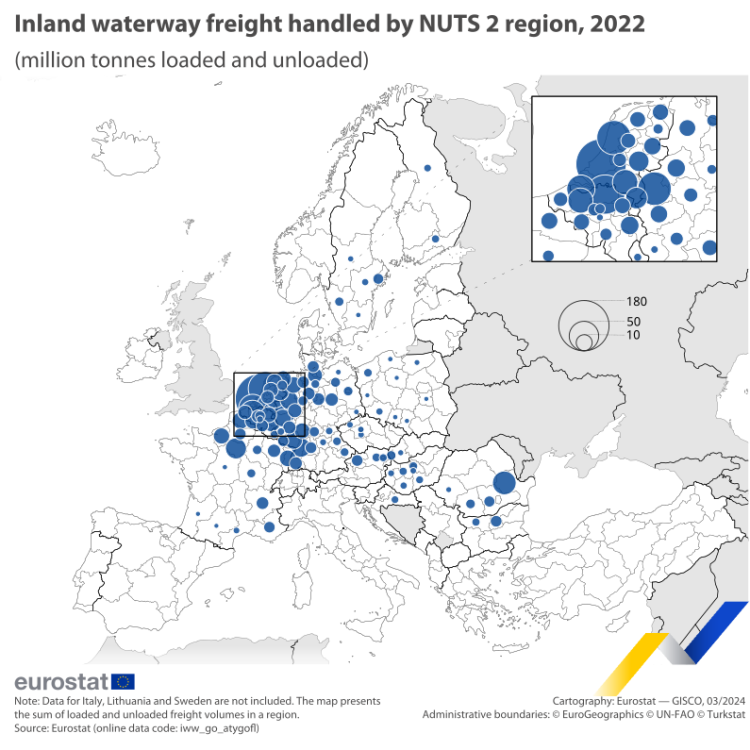
(million tonnes loaded and unloaded)
‘‘Source’’: Eurostat (iww_go_atygofl)
This article presents regional statistics on inland waterway freight transport in the European Union (EU) and non-EU countries connected to the EU inland waterway network. It focuses on regional data for total transport and container transport. For an overview of the annual and quarterly inland waterway transport, please refer to the Statistics Explained article Inland waterway freight transport - quarterly and annual data.
Full article
Inland waterway freight handled in Zuid-Holland (NL33) represented 18 % of the EU total in 2022
In 2022, 965 million tonnes of freight were handled, i.e. loaded and unloaded, in the EU by inland waterways. Map 1 presents the inland waterway freight handled by NUTS 2 region in 2022. Data are available for 104 EU NUTS 2 regions out of 189 NUTS 2 regions included in the countries reporting inland waterway transport. Zuid-Holland (NL33) ranked first in 2022 with 172.0 million tonnes, accounting for 17.8 % of the total inland waterway freight handled in the EU. Prov. Antwerpen (BE21) followed with 98.3 million tonnes (or 10.2 %), ahead of Noord-Holland (NL32) with 71.6 million tonnes (or 7.4 %), Düsseldorf (DEA1) with 67.9 million tonnes (or 7.0 %) and Zeeland (NL34) with 44.9 million tonnes (or 4.7 %). Completing the picture with Noord-Brabant (NL41) at 34.8 million tonnes (3.6 %), the cumulative share crosses the halfway mark at 50.7 %. It can be noted that 26 NUTS 2 regions contributed to 82.9 % of the total freight handled in the EU, individually contributing between 17.8 % and 1.0 %. The remaining 27.1 % is dispersed among 78 other regions, each contributing less than 1 % individually.

(million tonnes loaded and unloaded)
‘‘Source’’: Eurostat (iww_go_atygofl)
The map shows a heavy concentration of handled freight in a few key regions, mainly located in the Netherlands, Belgium and Germany, with many regions contributing smaller volumes and showing the widespread nature of inland waterway freight across the EU. This is not surprising, as these three countries have extensive inland waterway networks that play a major role in their national transport systems. These networks are also connected to major ports such as Rotterdam, Antwerp and Hamburg, which are key hubs for imports to and exports from the EU. Figure 1 presents the freight handled in the top 20 NUTS 2 regions in 2022, as well as the freight that had been handled in the same regions in 2021. While most regions of the top 20 experienced a decrease from 2021 to 2022, five regions recorded growth: Zeeland (NL34) saw an increase of 8.5 %, Prov. Oost-Vlaanderen (BE23) 5.3 %, Noord-Brabant (NL41) 3.8 %, Karlsruhe (DE12) 2.9 % and Prov. Liège (BE33) 0.6 %. In contrast, Sud-Est (RO22) experienced a significant decline from 37.7 million tonnes in 2021 to 29.2 million tonnes in 2022, the most substantial drop among the top 20 (-22.5 %). Köln (DEA2), Ile-de-France (FR10) and Limburg (NL42) also recorded substantial decreases of more than 10 %.
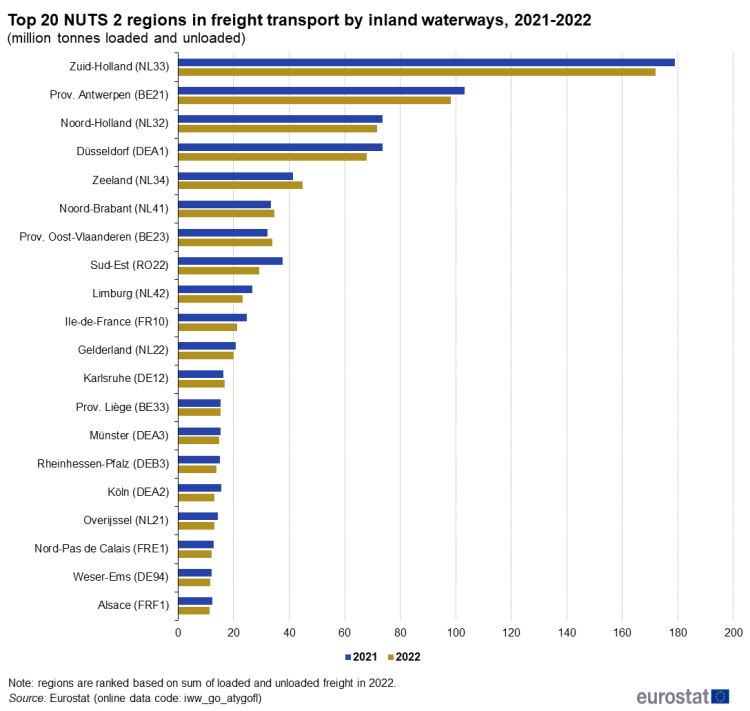
(million tonnes loaded and unloaded)
‘‘Source’’: Eurostat (iww_go_atygofl)
In 2022, four regions were ranked lower in the list of the top 20 and six regions were ranked higher compared with 2021. Nine regions remained in the same position. Weser-Ems (DE94) entered the top 20 at the expense of Haute-Normandie (FRD2) which is no longer in the top 20 in 2022.
The top 20 NUTS 2 regions for inland waterway freight handled accounted for more than three quarters (76.6 %) of the total inland waterway freight handled in the EU in 2022, about the same as in 2021 (76.7 %).
Figure 2 presents the distribution between loaded and unloaded inland waterway freight across the top 20 NUTS regions in 2022, highlighting the diverse dynamics of freight movement.
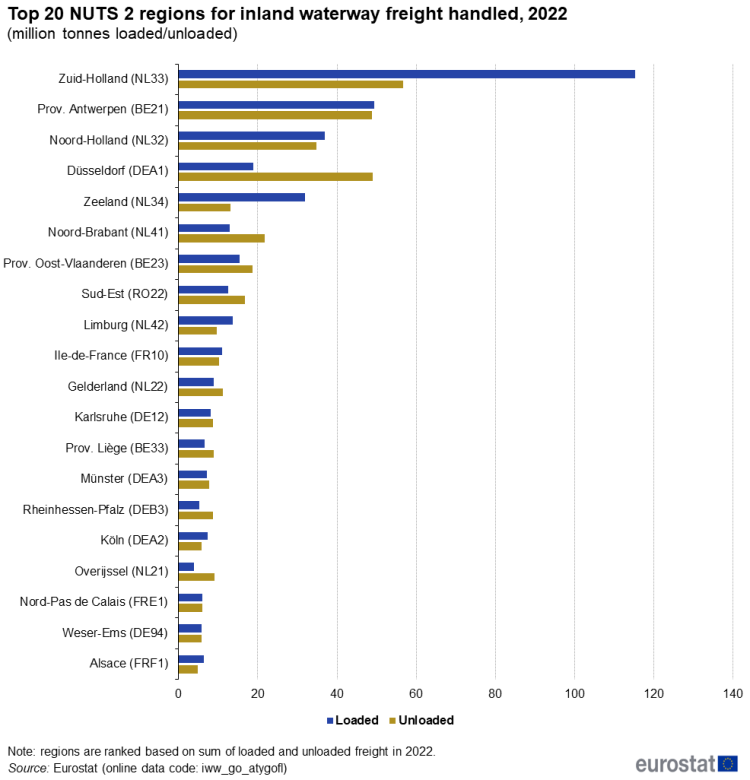
(million tonnes loaded/unloaded)
‘‘Source’’: Eurostat (iww_go_atygofl)
Zeeland (NL34) and Zuid-Holland (NL33) had a clear emphasis on loaded freight, with 71 % and 67 % of their handled freight being loaded in 2022, respectively. Five other regions, Limburg (NL42), Alsace (FRF1), Köln (DEA2), Noord-Holland (NL32) and Ile-de-France (FR10), also leaned slightly more towards loaded freight with ratios between 58 % and 52 % in 2022. This could suggest that these regions are significant producers or transit points for goods heading elsewhere.
In contrast, Düsseldorf (DEA1) and Overijssel (NL21) primarily served as a destination for goods, with their unloaded freight accounting for 72 % and 70 % in 2022, respectively. Eight other regions had prominent unloaded freight shares, ranging between 52 %, for Münster (DEA3), to 63 %, for Noord-Brabant (NL41), implying they might be key recipients, transit points or consumers of goods.
Prov. Antwerpen (BE21), Nord-Pas de Calais (FRE1) and Weser-Ems (DE94) exhibit an almost even balance between loaded and unloaded freight, settling close to a 50-50 distribution.
‘Metal ores’ is the largest goods category handled in most of the top 20 NUTS 2 regions
Table 1 presents the top three goods categories handled in the top 20 NUTS 2 regions for inland waterway transport in 2022. It should be noted that the data presented in this table may be influenced by the tonnage of unidentifiable goods reported, in particular when analysing the shares of each type of goods. Unidentifiable goods are goods which for any reason cannot be identified and therefore cannot be assigned to the other NST2007 divisions. The tonnage of unidentifiable goods was particularly high for some regions such as Prov. Antwerpen (BE21) (60 %) and Prov. Oost-Vlaanderen (BE23) (65 %). Unidentifiable goods have not been considered as one of the top three categories. However, if they would, this would make that category appear in the top three types of goods. This would be also the case for Düsseldorf (DEA1) (10 %), Noord-Brabant (NL41) (16 %), Limburg (NL42) (10 %) and Ile-de-France (FR10) (5 %).
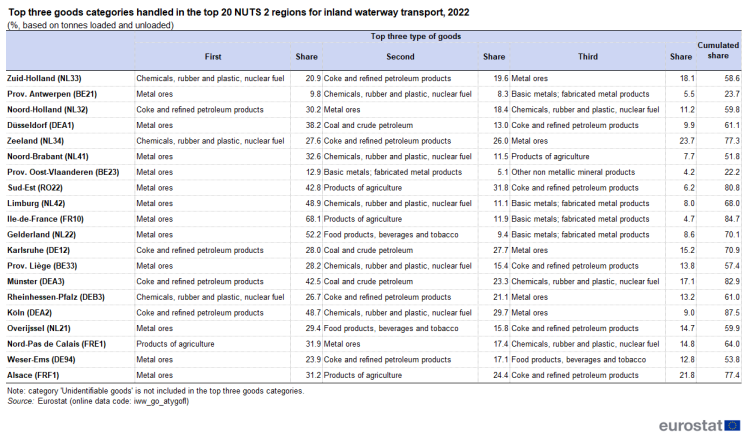
(%, based on tonnes loaded and unloaded)
‘‘Source’’: Eurostat (iww_go_atygofl)
‘Metal ores and other mining and quarrying products; peat; uranium and thorium’ (NST2007 division 03) appears to be the leading commodity, representing the primary type of good for 12 regions of the top 20, being second in two regions and third in five additional regions. The only region not having this product category in the top three was Münster (DEA3). When looking at the shares of this product category in total inland waterway freight transport in each region, it was particularly high in Ile-de-France (FR10), at 68.1 %, and in Gelderland (NL22), at 52.2 %. In two other regions, Sud-Est (RO22) and Limburg (NL42), the share was above 40 %.
‘Coke and refined petroleum products’ (NST2007 division 07) also emerged as a prominent category, being the top product in four regions, second in four and third in five regions. The highest shares for this product were observed in Köln (DEA2), at 48.7 %, and Münster (DEA3), at 42.5 %.
‘Chemicals, chemical products, and man-made fibers; rubber and plastic products ; nuclear fuel’ (NST2007 division 08) also held a notable presence, ranking first in three regions, second in five regions and third in three regions. Zeeland (NL34) and Rheinhessen-Pfalz (DEB3) had the highest shares for this product, at 27.6 % and 26.7 %, respectively.
One of the three above-mentioned products was in first place in all regions of the top 20, except in Nord-Pas de Calais (FRE1) where ‘products of agriculture, hunting, and forestry; fish and other fishing products’ (NST2007 division 01) came first, with a share of 31.9 % on total inland waterway freight tonnage in this region. This product was also present in second position in three regions and third in one region.
To complete the picture, four further product categories appeared in the top three places for the top 20 regions. These four product categories are: ‘food products, beverages, and tobacco’ (NST2007 division 04) – twice in second place and once in third place; ‘coal and lignite; crude petroleum and natural gas’ (NST2007 division 02) – three times in second place; ‘basic metals; fabricated metal products, except machinery and equipment’ (NST2007 division 10) – once in second place and four times in third place; and ‘other non-metallic mineral products’ (NST2007 division 09) – once in third place.
When looking at the cumulated share of the top three commodities, Köln (DEA2) topped the list with 87.5 %. Close followers included Ile-de-France (FR10) at 84.7 %, Münster (DEA3) at 82.9 % and Sud-Est (RO22) at 80.8 %. The cumulated share represented more than 50 % in all the top 20 regions, with the exception of Prov. Oost-Vlaanderen (BE23) with 22.2 % and Prov. Antwerpen (BE21) with 23.7 %. However, the share for these two regions is largely influenced by the high level of unidentifiable goods reported (65 % and 60 %, respectively).
Zuid-Holland (NL33) is a pivotal hub in the inland waterway transport network
Table 2 presents the top 20 NUTS 2-NUTS 2 region flows for inland waterway freight transport in 2022. It shows that the transport involving Zuid-Holland (NL33) accounted for 22.3 % of the total tonnage handled in the EU in 2022. Zuid-Holland (NL33) appeared in 11 of the top 20 NUTS 2-NUTS 2 region flows. In particular, this region appeared in all the top six flows. When considering the flows between Zuid-Holland (NL33) with Düsseldorf (DEA1), 32.6 million tonnes (or 6.8 % of total inland waterway freight handled in the EU) were loaded in Zuid-Holland (NL33) and unloaded in Düsseldorf (DEA1); whereas 4.5 million tonnes (or 0.9 %) were loaded in Düsseldorf (DEA1) and unloaded in Zuid-Holland (NL33).

‘‘Source’’: Eurostat (iww_go_atygofl)
Other regions well represented were Prov. Antwerpen (BE21), with six appearances in the top 20 flows, Düsseldorf (DEA1), with four appearances, Noord-Holland (NL32) and Zeeland (NL34), with three appearances each. Three other regions appeared in two flows: Sud-Est (RO22), Noord-Brabant (NL41) and Ile-de-France (FR10). To complete the picture, Ukraine, Prov. Oost-Vlaanderen (BE23) and Haute-Normandie (FRD2) appear once in the top 20 flows.
Freight loaded and unloaded within Zuid-Holland (NL33) represented 1.4 % of total freight handled in the EU (or 6.5 million tonnes). Three other regions witnessed significant internal freight transport: tonnage transported within Sud-Est (RO22) accounted for 6.5 million tonnes in 2022, representing 1.4 % of total inland waterway freight handled in the EU. Ile-de-France (FR10) and Prov. Antwerpen (BE21) also showed strong internal flows, each contributing 1.2 % to the total transport share, with 5.8 and 5.7 million tonnes handled, respectively.
Despite the prominence of these top 20 routes, the largest share of tonnage transport was encapsulated in a wide network of 2 794 remaining routes, with 327.3 million tonnes handled, accounting for 68.5 % of total inland waterway freight handled in the EU. Each of these routes had a share of less than 0.8 %. This underscores the vast and varied connectivity of the inland waterway transport network, suggesting that while certain routes are undoubtedly significant, the overall system thrives on a dense web of diverse transport routes.
Zuid-Holland (NL33) and Prov. Antwerpen (BE21) accounted for almost half of total inland waterway freight in containers handled in the EU in 2022
Map 2 presents inland waterway freight in containers handled, expressed in twenty-foot Equivalent Units (TEUs), by NUTS 2 region in 2022. Data are available for 57 EU NUTS 2 regions. Zuid-Holland (NL33) ranked first in 2022 with 3.8 million TEUs, accounting for 30.1 % of the total inland waterway freight in containers handled in the EU. Prov. Antwerpen (BE21) followed with 2.4 million tonnes (or 19.3 %). Summing up these two regions, they accounted for almost half (49.4 %) of the total inland waterway freight in containers handled in the EU. Düsseldorf (DEA1) followed with 0.8 million tonnes (or 6.6 %).
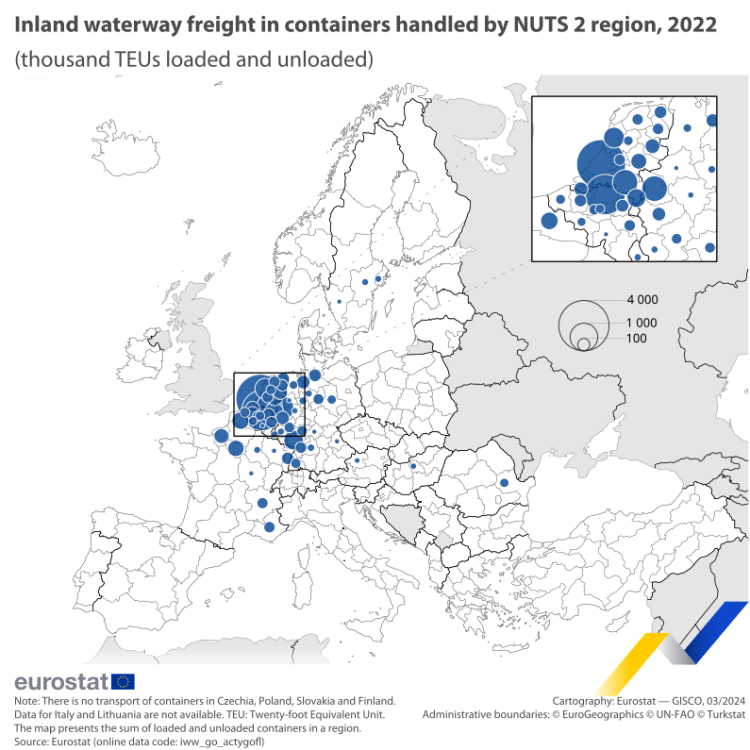
(thousand TEUs loaded and unloaded)
‘‘Source’’: Eurostat (iww_go_actygofl)
It can be noted that 11 NUTS 2 regions contributed to 80 % of the total freight in containers handled in the EU and 20 NUTS 2 regions contributed to 90 %. The remaining 10 % is dispersed among 26 other regions, each contributing less than 1 % individually. The map shows a heavy concentration of inland waterway freight transported in containers in a few key regions, mainly located in the Netherlands, Belgium and Germany. These three countries have extensive inland waterway networks that play a major role in their national transport systems. These networks are also connected to major ports such as Rotterdam, Antwerp and Hamburg, which are major ports for transport of containers.
Figure 3 presents the top 20 NUTS 2 regions for handling containers for inland waterway transport in 2022, as well as the containers that had been handled in the same regions in 2021. While most regions of the top 20 experienced a decrease between 2021 and 2022, four regions recorded a growth. Nord-Pas de Calais (FRE1) increased by 28.2 %, Alsace (FRF1) by 22.7 %, Gelderland (NL22) by 13.7 % and Limburg (NL42) by 1.5 %. In contrast, Haute-Normandie (FRD2) experienced a significant decline from 297 000 TEUs in 2021 to 194 000 TEUs in 2022, the most substantial drop among the top 20 regions (-34.8 %). Similarly, Prov. Oost-Vlaanderen (BE23) recorded a large decline of 30.9 %. Prov. Limburg (BE22), Bremen (DE50), Overijssel (NL21) and Köln (DEA2) also recorded substantial decreases of more than 10 %.

(thousand TEUs loaded and unloaded)
‘‘Source’’: Eurostat (iww_go_actygofl)
In 2022, four regions were ranked lower in the list of the top 20 and five regions were ranked higher compared with 2021. Ten regions remained in the same position. Alsace (FRF1) entered the top 20 at the expense of Prov. Liège (BE33) which is no longer in the top 20 in 2022.
Figure 4 presents the distribution between loading and unloading containers for inland waterway transport across the top 20 NUTS regions in 2022. Compared with the total inland waterway freight transport, transport of containers is more balanced when analysing their loading and unloading in a region. Half of the top 20 NUTS 2 regions showed an almost balanced activity between loading and unloading containers, with a 50-50 % or 51-49 % or 49-51 % distribution.
Prov. Antwerpen (BE21) emerged predominantly as a destination for freight in containers, with 59 % of containers there being unloaded in 2022. Other regions with a similar situation included Alsace (FRF1) with 53 % and Limburg (NL42) with 52 % of containers being unloaded in 2022.

(thousand TEUs loaded/unloaded)
‘‘Source’’: Eurostat (iww_go_actygofl)
In contrast, Köln (DEA2) leaned slightly more towards containers being loaded, registering 57 % of the total TEU handled in this region in 2022. Zuid-Holland (NL33), Gelderland (NL22) and Prov. Oost-Vlaanderen (BE23) also demonstrated a preference for loading containers, each with ratios of 55 % in 2022. Three other regions, namely Rheinhessen-Pfalz (DEB3), Hamburg (DE60) and Prov. Limburg (BE22), had higher container loading activity than unloading, with a 52-48 % distribution in 2022.
Source data for tables and graphs
Data sources
All figures presented in this article have been extracted from the Eurostat online database on inland waterway transport. The related datasets are collected according to Regulation (EU) 2018/974 of the European Parliament and of the Council on statistics of goods transport by inland waterways.
Regulation (EU) 2018/974 states that data must be supplied by all Member States for which the total volume of goods transported annually by inland waterways exceeds 1 million tonnes. Currently, 17 Member States provide data on a mandatory or voluntary basis: Belgium (BE), Bulgaria (BG), Czechia (CZ), Germany (DE), France (FR), Croatia (HR), Italy (IT), Lithuania (LT), Luxembourg (LU), Hungary (HU), the Netherlands (NL), Austria (AT), Poland (PL), Romania (RO), Slovakia (SK), Finland (FI) and Sweden (SE). Thirteen Member States (previously 12, but since 2022, Sweden also fulfils the requirements for mandatory reporting) have a legal obligation to provide data for inland waterway transport, including transport of goods by region of loading and unloading. The legal act requires only the provision of a reduced annual dataset for countries exceeding the threshold of 1 million tonnes but where no international or transit traffic exists.
Country specific notes
Italy: no data available at regional level.
Lithuania: no data available at regional level.
Breakdown by group of goods The NST 2007 classification is available on Eurostat website.
Context
The content of this statistical article is based on data collected under Regulation (EU) No 2018/974 of the European Parliament and of the Council on statistics of goods transport by inland waterways.
Direct access to
- Transport, see table under 'Inland waterways transport':
- Inland waterways transport (t_iww)
- Goods transport by inland waterways (ttr00007)
- Transport, see datasets under the following categories:
- Inland waterways transport (iww)
- Inland waterways transport infrastructure (iww_if)
- Inland waterways transport equipment (iww_eq)
- Inland waterways transport - Enterprises, economic performances and employment (iww_ec)
- Inland waterways transport measurement - goods (iww_go)
- Inland waterways - accidents (iww_ac)
- Regulation (EU) No 2018/974 of the European Parliament and of the Council on statistics of goods transport by inland waterways
- Summaries of EU legislation: EU statistics of goods transport by inland waterways
- Regulation (EC) No 1365/2006 on statistics of goods transport by inland waterways
- Commission Regulation (EC) No 425/2007 (implementing regulation)
- Commission Regulation (EC) No 1304/2007 (amending regulation)
- Regulation (EU) No 2016/1954 (amending regulation)